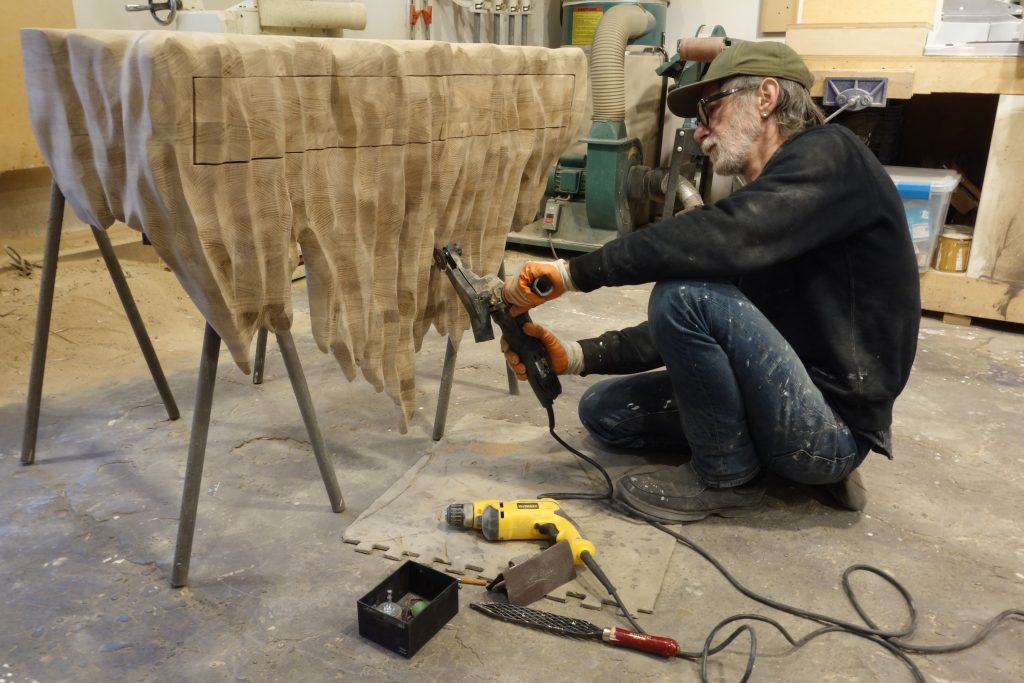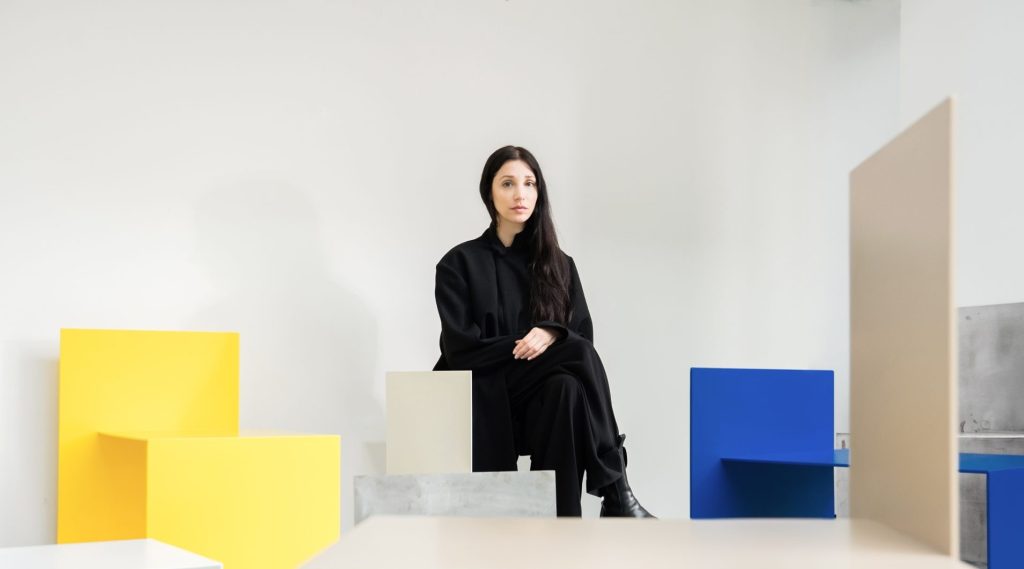Josefina Muñoz at Crossovers: Creation through Collaboration in a Circular Economy
“As a designer, I seek to inspire, inform
and provide a voice to artistic professions”
View Josefina Muñoz’s work, Game of Stone, in the Swiss Collection for Crossovers.
When first introduced, mass production was hailed as the way of the future, and like it or not it is one of the major forces that has enabled the many comforts we enjoy of modern living. If we think of depictions of what people during the 1920s imagined life after the second millennia to become, it was to be a world dominated by machine-reliant, artificial uniformity, with a bleak and cold absence of uniqueness or any resemblance of a natural world. Now that we’ve actually reached this time, a general, well-informed consensus has left this honeymoon phase and we begin to see the effects that this quest for perfection and in it the removal of human touch from our objects has had not only our natural world but on our internal worlds as well. Hand-made and unique design can be seen as a response to this meaningless amalgamation and the endless proliferation of stuff we have somehow been trapped into thinking will make our lives easier or better at all. In a post-industrial area when appreciation for artisanship is finally back on the rise, could it already be too late? Has our obsession with mass production already made us pay the price and lose out on these age-old techniques for good and what will it ever take to salvage these valuable traditions?
Geneva-based Argentine designer, Josefina Muñoz takes a macro perspective to the world of contemporary design and the influential sometimes seemingly distant factors that determine the industry’s course. With training in Design for Luxury and Craftsmanship, Muñoz designs with a keen sense of underlying meanings and symbolism that go hand in hand with quality. In her work for Pietretrovanti, the circular forms while embodying a soothing visual precision synonymous with Swiss design also tell the story of the circular economy. The uneven blocks of marble from which the objects have emerged has been pushed to limits to maximize the use of this material during every stage of development.
As a designer Muñoz fully recognizes the importance and necessity of maintaining traditional crafts and fully incorporates craftspeople and local crafts traditions as an integral part of her design practice. Her works embody the principals that we as consumers and the will design world at large will need to embrace for its prosperity. Whether it is to shed a light on the utilization of waste materials or maintaining and strengthening traditional artisan values, Muñoz’s work puts the spotlight back on the value of objects, the people who made them, where they came from and their place in our lives. Muñoz shared with us her unique process when it comes to creating these pieces and the stories of collaboration each work carries.
Vases MN, black sandstone and transparent enamel
How do you view your role as a designer in addressing issues such as hyper-commodification and overconsumption?
With my creations, I aspire to give the opportunity for the viewer to live a moment of serenity. In a world where everything goes so fast, the general public loses the notion of how these objects arrived to their hands. In a way both indirectly and through the material itself, the spectator has the opportunity to relearn the value of time by asking themselves questions when facing these objects – who made them come alive, how they are close and how they are touchable. I think any person can feel a certain nostalgia of owning an object that has been made by hand, in few quantities and in which you can perceive the love and attention with which is was thought of and produced. As a designer, I seek to inspire, inform and provide a voice to artistic professions such as ceramic, stone and glass, among others.
Atacama, ceramic vases
In the series you are exhibiting at Crossovers, Game of Stone, what inspired you to begin investigating production for a circular economy, and how did the material, marble, in particular, fit into this investigation?
Working with marble was not on my list of preferred materials, even though I do really love the material, I have always found it cold and distant. However, in 2016, I met Tiziana Scagiga, the artistic director of Pietretrovanti – a project that was focused on reevaluating discarded stone within the heart of a company in the north of Italy, boarding Switzerland.
This encounter made me change my mind completely about this magnificent material. The fact of working with discarded marble in a circular way, gave way to a symphony of restrictions and challenges that required a more complex and deep thought so that the project had a reason to be.
Starting from an irregular block of marble, both imperfect and discarded, it gave me the unique opportunity to explore a totally different approach to the creation; using cylinders that came from drilling to create concave pieces – creating a vast irregularity of proportions and shapes.
Game of Stone, collection of marble tables
Apart from this series, much of your work actually is done in close collaboration with crafts workers and workshops, why do you think is so important today in contemporary design?
I feel that the artisanal production techniques in the world of contemporary design answers to the booming market of collectible design. Thanks to today’s phenomena, there can be a surge of metiers d’art that sadly face an uncertain future.
Designers and artists nourish each other to achieve results that are more interesting, as its not just about the different artistries but each artisan can respond differently to the same project, making the possibility of combining design and artistry be infinite and exciting.
Paysages Désertiques, ceramic plates
What is your process like in creating with these crafts workers, and how do you balance showcasing their unique voices and input with your own?
I LOVE this question, as it is the part that I enjoy the most about my work, but also the most complex. The key is in listening – each artisan has such wisdom to share and to avoid the imposition of the pride of the designer, it allows to absorb so much information that can provide personalities to the project that are unique and special.
This is the case for the project ‘the soul of black clay’ in which the communication was immensely challenging – as I had no spoken language to rely on with these artisans in China. By focusing only on observation, I was able to put a touch to my work that shows through an aesthetic of the environment in which it was created. It was very exciting to see that the master artisan was witnessing my pieces in both China and the West at the same time.
That is why collaboration is of the utmost importance – respecting the limited of each field of creation – some unimaginable things can happen for both.


The Soul of Black Clay, 9-ceramic-pieces collection inspired by Chinese ceremony tea sets
What are some of your most important artistic inspirations, and where do you search for new inspiration when you are about to begin a new series of works?
My work is very material based and tactile. Thus, my first source of inspiration is the material itself and its techniques of production. I can feel connected by a detail or a characteristic, a form or a mistake. For example, my work of Atacama and Paysages Désertiques, the starting point was the very small surface of the cracking enamel on a piece that was kept at the artisan’s workshop.
Also, I reference elements in books, exhibitions, and material that I discover in contemporary art and from the XX century. But in reality, my radar of creation is always open to all types of stimuli that can give me the starting points for the creation process.
Leather Vases, boiled leather, formed with water then hardened with beeswax
Crossovers by Adorno will present a range of collections of dynamic works by independent designers from a selection of local scenes. The exhibition celebrates the designers and communities playing a central role in maintaining and renewing today’s local design and crafts cultures. Muñoz’s work and the works presented in the Swiss Collection by Davide Fornari represent a devotion to mindful design and functionality, challenging our use of and value of objects in an era plagued by the cult of consumerism. Presenting these works together with works from 10 other top design scenes from around the world creates a cross-cultural dialogue to examine the current state and future of contemporary design.
To preview the Swiss collection and stay up to date on the release of further news & previews sign up to our newsletter below.
Supported by:



Bio
Josefina Muñoz (1986) is a designer based in Geneva, Switzerland, specialized in product design and craft short-series. Originally from Argentina, she has a MAS of advanced studies in Design for Luxury and Craftsmanship from ECAL.
Nominated for Swiss Design Awards 2019, Winner of the Art & Design Indosuez Award 2019 of the Art and Crafts Switzerland Association, she participated in exhibitions around the world, including the Milan Design Week (2016, 2017, 2018) “De Mains de Maîtres” in Luxembourg (2017), the London Design Festival at the Victoria and Albert Museum in 2015 and Collect 2019 at Saatchi Gallery in London.
Her personal work in close partnership with true artisans in different fields, finding the particularities of individual expertise that offer a whole new world of artistic expressions.
Josefina is currently working with marble, glass and textile projects. After starting her own studio in 2016, she is perpetually seeking out new experiences and collaborations around the world.




